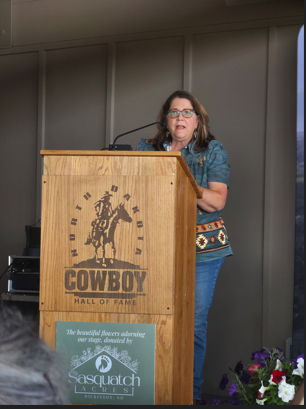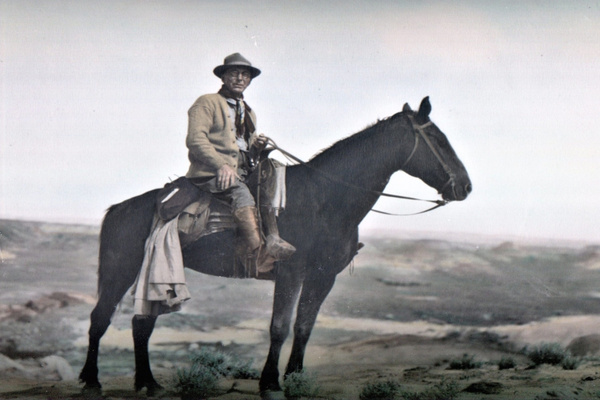The Theodore Roosevelt Center (TRC) and Dickinson State University (DSU) are pleased to announce we will be displaying an award given posthumously to Dr. Victor Hugo Stickney, a contemporary and friend of Theodore Roosevelt, and pivotal figure in the history and development of Dickinson and DSU.
 On Saturday, June 14, the North Dakota Cowboy Hall of Fame (NDCHF) held its annual
Induction Ceremony at Tjaden Terrance in Medora. Seven honorees were inducted in six
categories: Pre-1940s Ranching, Modern Era Ranching, Pre-1970s Rodeo, Modern Era Rodeo,
Western Art and Entertainment, and Great Westerner. This year’s Great Westerner award
was given to Dr. Victor Hugo Stickney (1855-1927) of Dickinson.
On Saturday, June 14, the North Dakota Cowboy Hall of Fame (NDCHF) held its annual
Induction Ceremony at Tjaden Terrance in Medora. Seven honorees were inducted in six
categories: Pre-1940s Ranching, Modern Era Ranching, Pre-1970s Rodeo, Modern Era Rodeo,
Western Art and Entertainment, and Great Westerner. This year’s Great Westerner award
was given to Dr. Victor Hugo Stickney (1855-1927) of Dickinson.
Mary Pat Martell Jones, a writer and trustee for the NDCHF who arranged for the award, has graciously donated the engraved crystal vase to the TRC to be displayed on the DSU campus. Jones feels the work of organizations like the NDCHF in preserving the stories of men like Stickney is crucial. While doing research, Jones discovered that Stickney had not yet been inducted into the NDCHF, and took on the role of his advocate. “Dr. Stickney is now a part of our past, but knowledge of his character and achievements gives us something to exemplify and build on as we live our lives and add to the history of our nation,” says Jones.
Victor Hugo Stickney was born April 13, 1855 in Plymouth, Vermont, and raised on the family farm. He studied medicine at Dartmouth, and came to Dakota Territory to practice in 1883, around the same time Theodore Roosevelt would arrive on the scene for the first time. Known as the “Cowboy Doctor,” Stickney had a reputation for being truly devoted to his cause. He traveled long distances on horseback or in a buckboard, and sometimes on a freight train or hand-car, to get to his far-flung patients. He sterilized his instruments in a Dutch oven. He never actively collected payments, accepting what was given from those who could afford it.
In 1886, Theodore Roosevelt marched into Dickinson with a trio of thieves in tow, turning them in to local justice Western Starr. Roosevelt had been walking for days in icy mud, and his feet were in terrible condition. He asked the first man he saw on the street where he could find a doctor to treat them. By chance, he had stumbled into the only professional physician in the region. Stickney later remembered Roosevelt this way:
This stranger struck me as the queerest specimen of strangeness that had descended on Dickinson in the three years I had lived there … He was all teeth and eyes. His clothes were in rags from forcing his way through the rosebushes that covered the river bottoms. He was scratched, bruised, and hungry, but gritty and determined as a bulldog ... I had met the most peculiar and at the same time the most wonderful man I ever came to know.
 A few months later, Stickney invited Roosevelt to speak at Dickinson’s Independence
Day celebrations. In what turned out to be Roosevelt’s first great public address,
he declared “I like big things” and told the crowd that he felt as much as a Westerner
as an Easterner. Certainly the friendship of men like Stickney – himself a transplanted
Easterner – contributed to this feeling.
A few months later, Stickney invited Roosevelt to speak at Dickinson’s Independence
Day celebrations. In what turned out to be Roosevelt’s first great public address,
he declared “I like big things” and told the crowd that he felt as much as a Westerner
as an Easterner. Certainly the friendship of men like Stickney – himself a transplanted
Easterner – contributed to this feeling.
“Dr. Stickney was a man much like Roosevelt,” says Dr. Hansard, Outreach Coordinator for the TRC. “A gallant hero, a devoted family man, and a dedicated civic leader. The TR Center and DSU are pleased to play a part in honoring the legacy of the “Cowboy Doctor” by displaying his 2025 Great Westerner Award.”
In addition to the vase and a canvas print honoring all seven of this year’s inductees, the TRC will soon receive a copy of the information panel that hangs at the NDCHF. The award will first be displayed in the Theodore Roosevelt Reading Room in Lowman-Walton Hall. It will later travel to other locations on campus, including Stickney Hall, dedicated to Victor Hugo Stickney, and his wife Maggie Hays Stickney, in 1921.
Click here to watch the recorded induction ceremony
Click here to learn more about Victor Hugo Stickney
Click here to visit the Theodore Roosevelt Digital Library

